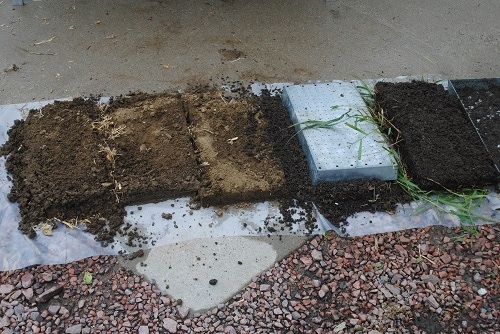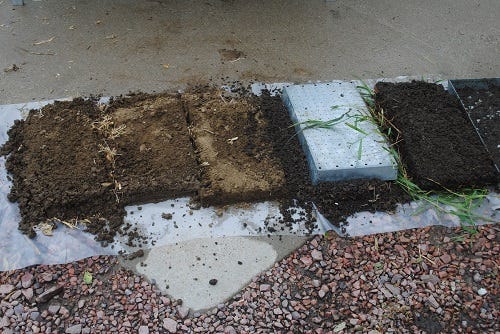

SEE THE DIFFERENCE: After being soaked with a rainfall simulator, soil with heavy residue and cover crops (right) are soaked through the profile, compared to tilled soils (center), where the water simply ran off.
At last week’s No-till on the Plains whirlwind tour stop at Matt Kathol’s farm near Hartington, the farmer discussions with no-till experts and technicians were telling (See gallery slideshow below). No-till farmers are generally quite committed to a philosophy that includes absolutely no tillage of their cropland soils. As University of Nebraska Extension engineer, Paul Jasa said so eloquently, “No-till is not just a planter. It is a systems approach to crop production.” To me, that means it requires knowing where you are starting from, understanding all of the components involved in the system, and implementing a well-conceived plan that is achievable and flexible enough to change if mistakes are made.
That’s a pretty tall order to begin with. Now, add another component to the mixture – cover crops. Most no-till farmers are convinced of the huge benefits of planting cover crops. However, they also understand the challenges. If you have been reading the UNL no-till listserve comments in recent days, you know that many no-till farmers are concerned about losing a cash crop because of cover crops, especially in regions of the Plains where drought has been persistent over the past few years.
This is a real concern. According to Matt Kathol, even after the extreme drought of 2012, cover crops on his farm have paid off. He saw yield drag only in places where he didn’t get cover crops planted or germinated in the fall of 2012. But for many, the opposite is true. They have experienced some crop losses, or at least substantial decreases in cash crop yield following cover crops.
These experiences pose a few questions. What was the cash crop and how moisture-hungry was it? What types of cover crops were planted and were they planted at the correct time? A huge question of great importance under these scenarios is whether or not the cover crop was terminated at the correct time, before it started to dry the soils for the cash crop. What soil types were involved? How bad is the drought in those areas? Farmers are asking these questions, not because they aren’t committed to adding cover crops, but because they understand the real obstacles, especially in more fragile soils and arid climates, and they want to make cover crops work in their own systems.
I’ve experienced my own failures in planting cover crops. Not terminating a heavy cover of rye can cause all kinds of problems in a dry spring. But simple and slight changes to the system, like grazing before termination or adding a cocktail mixture of cover crops more suited to specific soils, can make all of the difference.
RELATED
Cover Crop Termination Rules Updated by USDA
At the Kathol tour stop, NRCS no-till specialist, Dan Gillespie, used a rainfall simulator to show how well water infiltrates into soils with heavy residue and cover crops, compared to soils that were tilled. The results are pretty dramatic. So, my guess is that researchers and farmers will continue to work together to develop more specific systems to help farmers get a handle on what types of covers work best on their own farms. We might also see farmers tweaking which cash crops they plant following cover crops. They might even add a new cash crop or two into their rotations to help the system work better at building organic matter, scavenging soil moisture and nutrients and ultimately improving soil health. We know that cover crops have huge potential, and we are only now beginning to understand how much potential there is and how to tap into it. For now, the best information is coming from those veteran farmers and no-tillers, experienced researchers and cover crop seed specialists. Here is this week’s discussion question. What is your favorite cover crop mixture and what are your experiences in cash crop yield following cover crops? You can share your thoughts and observations here.
Watch for more on no-till farming on the Matt Kathol farm in an upcoming print article in Nebraska Farmer. Watch for the latest in farm news at Nebraska Farmer online, and be sure to follow us on Twitter at Husker Home Place.
About the Author(s)
You May Also Like






